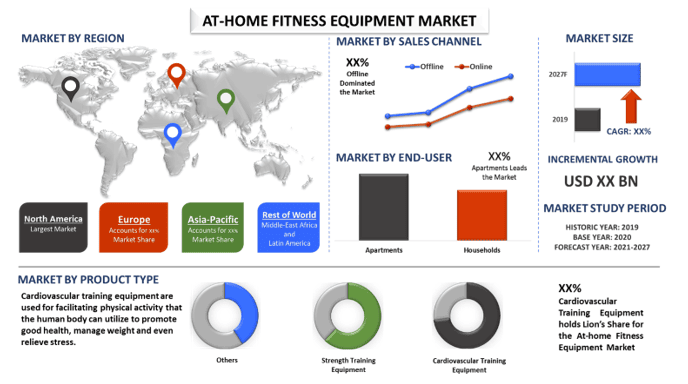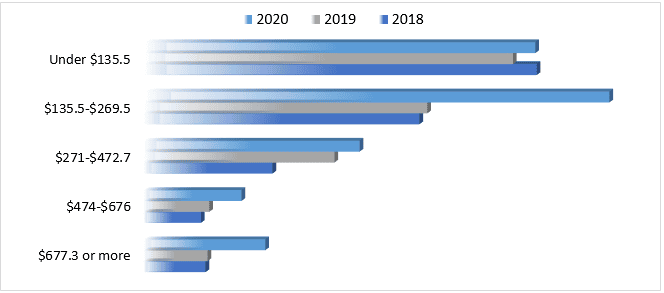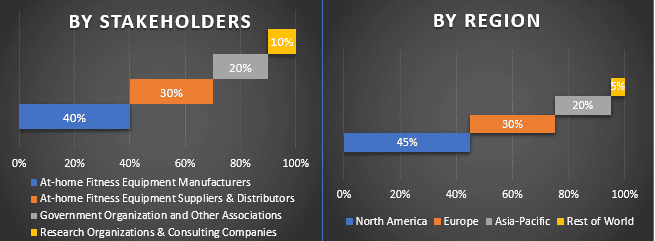
전 세계 가정용 피트니스 장비 시장은 2020년에 59억 2천만 달러로 평가되었으며, 예측 기간(2021-2027) 동안 연평균 성장률 4.97%로 증가하여 2027년에는 82억 4천만 달러에 이를 것으로 예상됩니다. 가정용 피트니스 장비는 근력을 강화하고 건강을 유지하며 체중 관리에 도움이 되도록 소비자가 집에서 편안하게 신체 활동을 위해 사용하는 모든 장치 또는 기계를 의미합니다.
직장인의 증가와 바쁜 일정 및 긴 근무 시간으로 인해 일부 피트니스 애호가들이 겪는 문제로 인해 많은 소비자들이 가정 운동 루틴을 적극적으로 채택하고 있으며, 이는 시장 성장을 촉진하고 있습니다. 또한, 가정 운동에 대한 증가하는 추세는 더 많은 소비자가 이러한 제품에 지출함에 따라 가정 운동 장비 판매를 촉진하고 있습니다. 예를 들어, 영국에서는 소비자의 거의 53%가 작년에 가정 운동 제품 구매에 평균 218 USD를 지출했습니다.
암, 심장 질환, 당뇨병을 포함한 만성 질환으로 고통받는 사람들의 전 세계적 부담 증가로 인해 가정용 장비에 대한 전 세계적 수요가 증가하고 있으며, 이는 사람들이 건강한 라이프스타일을 채택하도록 유도하여 가정용 피트니스 장비의 글로벌 시장을 주도할 것입니다. 예를 들어, WHO에 따르면 매년 4,100만 명이 비전염성 질환으로 사망하며 이는 전 세계 사망의 71%를 차지합니다. 또한, 운동 장비는 보디빌딩의 성장 추세로 인해 피트니스 애호가들 사이에서 큰 인기를 얻고 있으며, 이는 시장 성장을 촉진하고 있습니다. 그러나 시장의 제약 조건으로는 가정 운동에 사용할 수 있는 다양한 대안이 있습니다. 또한, 설치 및 기타 서비스 요구 사항으로 인해 가정용 피트니스 장비의 설치 및 서비스 비용이 증가하여 시장 성장을 저해하고 있습니다.
운동 장비 구매자 수, 영국, 지출별, 2018-2020 (천 명 단위)

Icon Health & Fitness Inc., Core Health & Fitness LLC, Johnson Health Tech Co. Ltd., Decathlon, Technogym SpA, Nautilus Inc., Echelon Fitness Multimedia LLC, TRUE Fitness, Dyaco International Inc., Rogue Fitness는 가정용 피트니스 장비 시장에서 활동하는 주요 업체 중 일부입니다. 이러한 업체들은 고객에게 새롭고 혁신적인 장비를 제공하기 위해 여러 M&A와 파트너십을 체결했습니다.
보고서에 제시된 인사이트
“제품 유형 중에서는 심혈관 훈련 장비 부문이 주요 점유율을 차지합니다.”
제품 유형을 기준으로 시장은 심혈관 훈련 장비, 근력 훈련 장비 및 기타로 나뉩니다. 심혈관 훈련 장비 부문은 2020년에 가장 높은 수익을 창출했으며 소비자들이 심혈관 건강에 대한 인식이 높아짐에 따라 예측 기간 동안 눈에 띄게 성장하여 2027F까지 시장을 주도할 것으로 예상됩니다. 또한 이 부문은 트레드밀, 일립티컬 머신, 고정식 자전거 및 로잉 머신으로 세분화됩니다. 이 중에서 고정식 자전거 부문은 2020년에 가정용 피트니스 장비 시장에서 상당한 시장 점유율을 확보했습니다.
“판매 채널 중에서는 오프라인 부문이 주요 점유율을 차지합니다.”
판매 채널을 기준으로 시장은 온라인과 오프라인으로 나뉩니다. 오프라인 부문은 주요 시장 점유율을 확보하고 시장을 지배했으며 수많은 피트니스 매장의 존재와 소비자가 자신의 요구 사항 및 필요에 따라 특정 제품을 구매하도록 안내하는 전문가의 존재로 인해 예측 기간 동안 급격한 CAGR로 성장할 것으로 예상됩니다. 그러나 온라인 부문도 예측 기간 동안 상당한 CAGR로 성장할 것으로 예상됩니다.
“최종 사용자 중에서는 아파트 부문이 주요 점유율을 차지합니다.”
최종 사용자를 기준으로 시장은 가구와 아파트로 나뉩니다. 아파트 부문은 2020년에 선도적인 시장 점유율을 확보했으며 예측 기간 동안 놀라운 CAGR로 성장할 것으로 예상됩니다. 이 부문의 성장은 대부분의 국가에서 아파트에 체육관을 건설하는 새로운 추세에 기인합니다. 예를 들어, 미국에서 2,000명의 임차인을 대상으로 실시한 2020년 설문 조사에 따르면 응답자의 거의 29%가 아파트의 체육관 또는 레크리에이션 스포츠 시설이 가장 중요한 가정 편의 시설이라고 답했습니다. 그러나 가구 부문은 향후 몇 년 동안 상당한 속도로 성장할 것으로 예상됩니다.
“북미는 가정용 피트니스 장비 시장에서 가장 큰 시장 중 하나를 나타냅니다.”
가정용 피트니스 장비 시장의 시장 역학을 더 잘 이해하기 위해 북미(미국, 캐나다 및 북미 나머지 지역), 유럽(독일, 프랑스, 스페인, 영국, 이탈리아 및 유럽 나머지 지역), 아시아 태평양(중국, 일본, 인도, 호주 및 APAC 나머지 지역), 세계 나머지 지역을 포함한 전 세계 여러 지역에 대한 자세한 분석이 수행되었습니다. 많은 소비자들이 건강을 유지하기 위해 정기적인 운동 요법에 참여하고 있기 때문에 북미는 증가하는 예방적 의료 조치로 인해 2020년에 시장을 지배했습니다. 그러나 아시아 태평양도 예상 기간 동안 상당한 CAGR로 성장할 것으로 예상됩니다.
이 보고서를 구매해야 하는 이유:
- 이 연구에는 인증된 주요 업계 전문가가 검증한 시장 규모 측정 및 예측 분석이 포함되어 있습니다.
- 이 보고서는 전체 산업 성과에 대한 빠른 검토를 한눈에 제공합니다.
- 이 보고서는 주요 비즈니스 재무, 제품 포트폴리오, 확장 전략 및 최근 개발에 중점을 두고 주요 산업 동료에 대한 심층 분석을 다룹니다.
- 산업 전반에 걸쳐 널리 퍼져있는 동인, 제약, 주요 동향 및 기회에 대한 자세한 조사
- 이 연구는 다양한 부문에 걸쳐 시장을 포괄적으로 다룹니다.
- 산업에 대한 심층적인 지역 수준 분석
사용자 정의 옵션:
글로벌 가정용 피트니스 장비 시장은 요구 사항 또는 기타 시장 부문에 따라 추가로 사용자 정의할 수 있습니다. 이 외에도 UMI는 귀하가 고유한 비즈니스 요구 사항을 가질 수 있음을 이해하므로 귀하의 요구 사항에 완벽하게 맞는 보고서를 얻기 위해 언제든지 저희에게 연락하십시오.
목차
글로벌 홈 피트니스 장비 시장의 역사적 시장 분석, 현재 시장 추정, 미래 시장 예측은 주요 지역에서 홈 피트니스 장비의 채택을 생성하고 분석하기 위해 수행된 세 가지 주요 단계였습니다. 역사적 시장 수치를 수집하고 현재 시장 규모를 추정하기 위해 철저한 2차 조사가 수행되었습니다. 둘째, 이러한 통찰력을 검증하기 위해 수많은 발견과 가정이 고려되었습니다. 또한 글로벌 홈 피트니스 장비 시장의 가치 사슬 전반에 걸쳐 업계 전문가와 함께 철저한 1차 인터뷰도 진행되었습니다. 1차 인터뷰를 통해 시장 수치를 가정하고 검증한 후, 전체 시장 규모를 예측하기 위해 상향식/하향식 접근 방식을 사용했습니다. 그 후, 시장 세분화 및 데이터 삼각 측량 방법을 채택하여 업계 관련 부문 및 하위 부문의 시장 규모를 추정하고 분석했습니다. 자세한 방법론은 아래에 설명되어 있습니다.
역사적 시장 규모 분석
1단계: 2차 출처에 대한 심층 연구:
연례 보고서 및 재무 제표, 실적 발표, 보도 자료 등과 같은 회사 내부 소스와 저널, 뉴스 및 기사, 정부 간행물, 경쟁사 간행물, 부문 보고서, 타사 데이터베이스 및 기타 신뢰할 수 있는 간행물을 포함한 외부 소스를 통해 홈 피트니스 장비의 역사적 시장 규모를 얻기 위해 자세한 2차 연구가 수행되었습니다.
2단계: 시장 세분화:
홈 피트니스 장비 시장의 역사적 시장 규모를 확보한 후, 주요 지역에 대한 다양한 부문 및 하위 부문에 대한 역사적 시장 통찰력과 점유율을 수집하기 위해 자세한 2차 분석을 수행했습니다. 보고서에 포함된 주요 부문으로는 제품 유형, 판매 채널, 최종 사용자가 있습니다. 또한 전 세계적으로 홈 피트니스 장비의 전반적인 채택을 평가하기 위해 국가 수준의 분석을 수행했습니다.
3단계: 요인 분석:
다양한 부문 및 하위 부문의 역사적 시장 규모를 확보한 후, 홈 피트니스 장비의 현재 시장 규모를 추정하기 위해 자세한 요인 분석을 수행했습니다. 또한 가처분 소득 증가 및 도시 인구 증가와 같은 종속 변수 및 독립 변수를 사용하여 요인 분석을 수행했습니다. 전 세계 홈 피트니스 장비 부문에서 최고의 파트너십, 합병 및 인수, 사업 확장 및 제품 출시를 고려하여 수요 및 공급 측면 시나리오에 대한 철저한 분석을 수행했습니다.
현재 시장 규모 추정 및 예측
현재 시장 규모 측정: 위의 3단계에서 얻은 실행 가능한 통찰력을 바탕으로 현재 시장 규모, 홈 피트니스 장비 시장의 주요 플레이어, 부문의 시장 점유율에 도달했습니다. 필요한 모든 백분율 점유율 분할 및 시장 세분화는 위에서 언급한 2차 접근 방식을 사용하여 결정되었으며 1차 인터뷰를 통해 검증되었습니다.
추정 및 예측: 시장 추정 및 예측을 위해 동인 및 추세, 제약, 이해 관계자가 사용할 수 있는 기회를 포함한 다양한 요인에 가중치를 할당했습니다. 이러한 요인을 분석한 후 관련 예측 기술, 즉 상향식/하향식 접근 방식을 적용하여 전 세계 주요 시장의 다양한 부문 및 하위 부문에 대해 2027년경의 시장 예측에 도달했습니다. 시장 규모를 추정하기 위해 채택된 연구 방법론은 다음과 같습니다.
- 가치(US$) 측면에서 업계의 시장 규모와 국내 주요 시장에서 홈 피트니스 장비의 채택률
- 시장 부문 및 하위 부문의 모든 백분율 점유율, 분할 및 세분화
- 제공되는 제품 측면에서 홈 피트니스 장비 시장의 주요 플레이어. 또한 빠르게 성장하는 시장에서 경쟁하기 위해 이러한 플레이어가 채택한 성장 전략
시장 규모 및 점유율 검증
1차 연구: 주요 지역의 최고 경영진(CXO/VP, 영업 책임자, 마케팅 책임자, 운영 책임자 및 지역 책임자, 국가 책임자 등)을 포함한 주요 오피니언 리더(KOL)와 심층 인터뷰를 진행했습니다. 그런 다음 1차 연구 결과를 요약하고 명시된 가설을 입증하기 위해 통계 분석을 수행했습니다. 1차 연구의 입력은 2차 결과와 통합되어 정보를 실행 가능한 통찰력으로 전환했습니다.
다양한 지역의 1차 참가자 분할

시장 엔지니어링
데이터 삼각 측량 기술을 사용하여 전체 시장 추정을 완료하고 홈 피트니스 장비 시장의 각 부문 및 하위 부문의 정확한 통계 수치에 도달했습니다. 홈 피트니스 장비 시장의 제품 유형, 판매 채널 및 최종 사용자 영역에서 다양한 매개 변수와 추세를 연구한 후 데이터를 여러 부문 및 하위 부문으로 분할했습니다.
홈 피트니스 장비 시장 연구의 주요 목표
홈 피트니스 장비의 현재 및 미래 시장 추세가 연구에서 정확히 지적되었습니다. 투자자는 연구에서 수행된 질적 및 양적 분석에서 투자를 위한 재량을 기반으로 전략적 통찰력을 얻을 수 있습니다. 현재 및 미래 시장 추세는 지역 수준에서 시장의 전반적인 매력을 결정하여 산업 참가자가 미개척 시장을 활용하여 선점자 이점을 누릴 수 있는 플랫폼을 제공했습니다. 연구의 다른 양적 목표는 다음과 같습니다.
- 가치(US$) 측면에서 홈 피트니스 장비의 현재 및 예측 시장 규모를 분석합니다. 또한 다양한 부문 및 하위 부문의 현재 및 예측 시장 규모를 분석합니다.
- 연구의 부문에는 제품 유형, 판매 채널 및 최종 사용자 영역이 포함됩니다.
- 홈 피트니스 장비 산업에 대한 규제 프레임워크를 정의하고 분석합니다.
- 다양한 중개자의 존재와 관련된 가치 사슬을 분석하고 업계의 고객 및 경쟁업체 행동을 분석합니다.
- 주요 지역에 대한 홈 피트니스 장비 시장의 현재 및 예측 시장 규모를 분석합니다.
- 보고서에서 연구된 주요 지역에는 북미, 유럽, 아시아 태평양 및 기타 지역이 포함됩니다.
- 홈 피트니스 장비 시장의 회사 프로필과 빠르게 성장하는 시장에서 지속하기 위해 시장 플레이어가 채택한 성장 전략
- 업계에 대한 심층적인 지역 수준 분석
관련 보고서
이 상품을 구매한 고객님들도 함께 구매하신 상품










